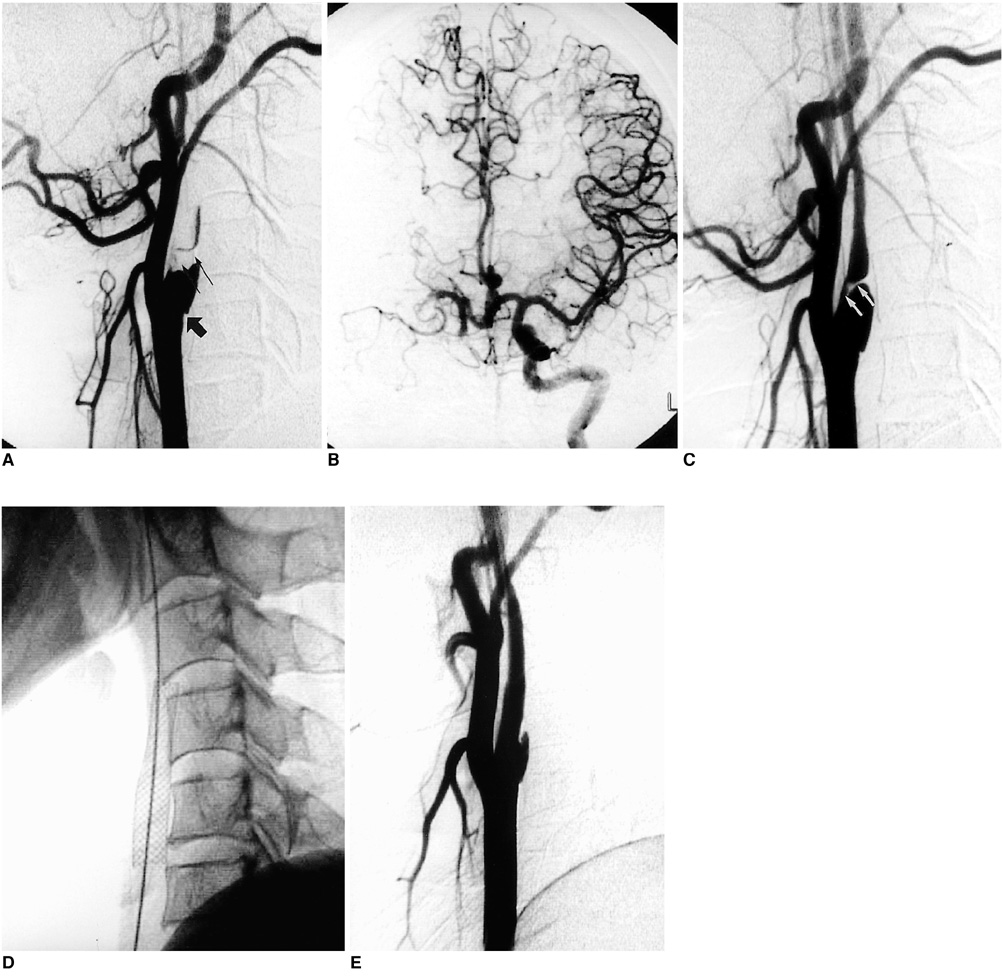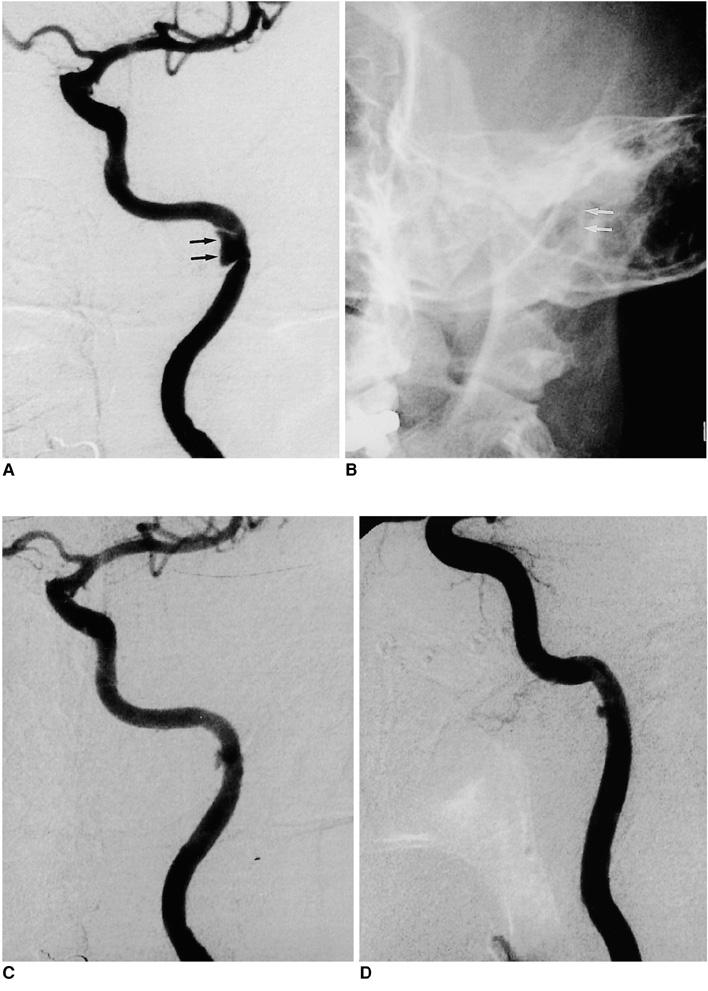Korean J Radiol.
2001 Mar;2(1):52-56. 10.3348/kjr.2001.2.1.52.
Treatment of Internal Carotid Artery Dissections with Endovascular Stent Placement: Report of Two Cases
- Affiliations
-
- 1Univ Ulsan,Kangnung Hosp Coll Med Dept Diagnost Radiol,415 Bandong Ri/Kangnung si 210711, Kangwon do, South Korea.
- KMID: 754123
- DOI: http://doi.org/10.3348/kjr.2001.2.1.52
Abstract
- Extracranial carotid artery dissection may manifest as arterial stenosis or occlusion, or as dissecting aneurysm formation. Anticoagulation and/or antiplatelet therapy is the first-line treatment, but because it is effective and less invasive than other procedures, endovascular treatment of carotid artery dissection has recently attracted interest. We encountered two consecutive cases of traumarelated extracranial internal carotid artery dissection, one in the suprabulbar portion and one in the subpetrosal portion. We managed the patient with suprabulbar dissection using a self-expandable metallic stent and managed the patient with subpet-rosal dissection using a balloon-expandable metallic stent. In both patients the dissecting aneurysm disappeared, and at follow-up improved luminal patency was observed.
Keyword
MeSH Terms
Figure
Reference
-
1. Anson J, Crowell RM. Cervicocranial arterial dissection. Neurosurgery. 1991. 29:89–96.2. Lucas C, Moulin T, Deplanque D, et al. Stroke patterns of internal carotid artery dissection in 40 patients. Stroke. 1998. 29:2646–2648.3. Mulloy JP, Flick PA, Gold RE. Blunt carotid injury: a review. Radiology. 1998. 207:571–585.4. Bejjani GK, Monsein LH, Laird JR, et al. Treatment of symptomatic cervical carotid dissections with endovascular stents. Neurosurgery. 1999. 44:755–760.5. Simionato F, Righi C, Scotti G. Post-traumatic dissecting aneurysm of extracranial internal carotid artery: endovascular treatment with stenting. Neuroradiology. 1999. 41:543–547.6. DeOcampo J, Brillman J, Levy DI. Stenting: a new approach to carotid dissection. J Neuroimaging. 1997. 7:187–190.7. Bernstein SM, Coldwell DM, Prall JA, Brega KE. Treatment of traumatic carotid pseudoaneurysm with endovascular stent placement. J Vasc Interv Radiol. 1997. 8:1065–1068.8. Coric D, Wilson JA, Regan JD, Bell A. Primary stenting of the extracranial internal carotid artery in a patient with multiple cervical dissections: technical case report. Neurosurgery. 1998. 43:956–959.9. Horowitz MB, Miller G III, Meyer Y, Carstens G III, Purdy PD. Use of intravascular stents in the treatment of internal carotid and extracranial vertebral artery pseudoaneurysms. AJNR. 1996. 17:693–696.10. Klein GE, Szolar DH, Raith J, et al. Post-traumatic extracranial aneurysm of the internal carotid artery: combined endovascular treatment with coils and stents. AJNR. 1997. 18:1261–1264.11. Chalmers RT, Brittenden J, Bradbury AW. The use of endovascular stented grafts in the management of traumatic false aneurysms: a caveat. J Vasc Surg. 1995. 22:337–338.12. Biousse V, D'Anglejan-Chatillon J, Touboul P, Amarenco P, Bousser M. Time course of symptoms in extracranial carotid artery dissections. Stroke. 1995. 26:235–239.13. Fabian TC, Patton JH Jr, Croce MA, et al. Blunt carotid injury: importance of early diagnosis and anticoagulation therapy. Ann Surg. 1996. 223:513–525.
- Full Text Links
- Actions
-
Cited
- CITED
-
- Close
- Share
- Similar articles
-
- Stent Angioplasty for Intracranial Vertebral Dissections: Single Stent versus Double Stent Placement
- Supra-aortic Arterial Recanalization: Report of 5 cases
- How to Escape Stentriever Wedging in an Open-cell Carotid Stent during Mechanical Thrombectomy for Tandem Cervical Internal Carotid Artery and Middle Cerebral Artery Occlusion
- Endovascular Treatment with a Stent-Graft for Internal Carotid Artery Laceration during Trans Sphenoidal Surgery: A Case Report
- Endovascular Treatment Using Multiple Stents for Symptomatic Intracranial Vertebral Artery Dissecting Aneurysm



